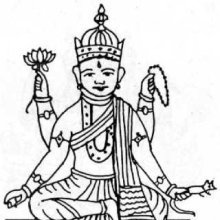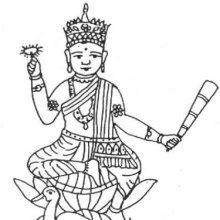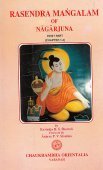Yakshini, Yakṣiṇī, Yakṣinī: 18 definitions
Introduction:
Yakshini means something in Buddhism, Pali, Hinduism, Sanskrit, Jainism, Prakrit, Marathi, Hindi. If you want to know the exact meaning, history, etymology or English translation of this term then check out the descriptions on this page. Add your comment or reference to a book if you want to contribute to this summary article.
The Sanskrit terms Yakṣiṇī and Yakṣinī can be transliterated into English as Yaksini or Yakshini, using the IAST transliteration scheme (?).
Images (photo gallery)
(+23 more images available)
In Hinduism
Shaivism (Shaiva philosophy)
Source: Wisdom Library: Kubjikāmata-tantraYakṣiṇī (यक्षिणी):—Name of one of the six female deities (yoginīs) springing forth from the body of Kuleśvara, the central male deity of the Yoginīcakra (fourth of the five internal cakras), according to the kubjikāmata-tantra. In other tantric sources, such as the Kulārṇava-tantra, she is identified as Hākinī. The name Yākinī (or Yakṣiṇī) is added as a seventh yoginī in the commentary on the Yoginīhṛdaya by Setubandha.
Yakṣiṇī is identified with the tattva-adhvan (on of the six paths, or adhvans) and relates to one thirty-six tattvas. The fearful character of Yakṣiṇī is represented by her eating marrow and semen (majjabījāśinī). She is situated in the Ājñā-cakra which is symbolic for her relation with one of the sixfold sites (ṣaṭpura). She is also related to astra, one of the six aṅgas.
Source: Shodhganga: Mantra-sādhana: Chapter One of the KakṣapuṭatantraYakṣiṇī (यक्षिणी) refers to a ritual that is accomplished by performing mantrasādhana (preparatory procedures) beginning with japamālā using a rosary bead made of conch shell beads, according to the Kakṣapuṭatantra verse 1.47, “to achieve artha (wealth), a rosary should be made from conch shell beads. To accomplish the nidhāna (treasure) and Yakṣiṇī ritual, the rosary should be strung with a white thread”.
Source: academia.edu: Yakṣiṇī-sādhana in the Kakṣapuṭa tantraYakṣiṇī (यक्षिणी).— In the yakṣiṇī-sādhana, the Yakṣiṇī is regarded as the guardian spirit who provides worldly benefits to the practitioner. The Yakṣiṇī provides, inter alia, daily food, clothing and money, tells the future, and bestows a long life, but she seldom becomes a partner in sexual practices.
The Yakṣiṇī is also regarded as the goddess of wealth. In the Kakṣapuṭa-tantra, the Yakṣiṇīs also appear in the Sarvāñjana-sādhana Chapter, in which they bestow the divine añjana, which makes buried treasure visible.The Yakṣa and Yakṣiṇī have been worshiped as gods and goddesses of fertility or wealth since ancient times.The Yakṣiṇīs in the Kakṣapuṭa-tantra seem to have inherited characteristics from the ancient Yakṣiṇī, but their character has slightly changed.Their relationship with the earth and fertility is no longer noticeable, but their relationship with dīnāra (gold coin) and rūpya (silver coin) is conspicuous. At the same time, their connection with a particular locality has also lost its importance.

Shaiva (शैव, śaiva) or Shaivism (śaivism) represents a tradition of Hinduism worshiping Shiva as the supreme being. Closely related to Shaktism, Shaiva literature includes a range of scriptures, including Tantras, while the root of this tradition may be traced back to the ancient Vedas.
Natyashastra (theatrics and dramaturgy)
Source: Wisdom Library: Nāṭya-śāstraYakṣiṇī (यक्षिणी) is a Sanskrit word referring to a group of female deities. Acording to the Nāṭyaśāstra 1.82-88, when Brahmā, Indra and all other gods went to inspect the playhouse (nāṭyamaṇḍapa) designed by Viśvakarmā, he assigned different deities for the protection of the playhouse itself, as well as for the objects relating to dramatic performance (prayoga).
As such, Brahmā assigned the Yakṣiṇīs to the rooms (veśman). The protection of the playhouse was enacted because of the jealous Vighnas (malevolent spirits), who began to create terror for the actors.

Natyashastra (नाट्यशास्त्र, nāṭyaśāstra) refers to both the ancient Indian tradition (shastra) of performing arts, (natya—theatrics, drama, dance, music), as well as the name of a Sanskrit work dealing with these subjects. It also teaches the rules for composing Dramatic plays (nataka), construction and performance of Theater, and Poetic works (kavya).
Purana and Itihasa (epic history)
Source: Cologne Digital Sanskrit Dictionaries: The Purana IndexYakṣinī (यक्षिनी).—A Śakti;1 an image of; surrounded by the Devas, Dānavas and the Nāgas; hoods and two tongues to be carved above the head; also the spirits of the air and the evil spirits encircle her.2

The Purana (पुराण, purāṇas) refers to Sanskrit literature preserving ancient India’s vast cultural history, including historical legends, religious ceremonies, various arts and sciences. The eighteen mahapuranas total over 400,000 shlokas (metrical couplets) and date to at least several centuries BCE.
Shaktism (Shakta philosophy)
Source: Google Books: ManthanabhairavatantramYakṣiṇī (यक्षिणी) refers to one of the six Goddesses (parā-ṣaṭka) associated with Tisrapīṭha (located in the ‘end of sound’—nādānta), according to the Manthānabhairavatantra, a vast sprawling work that belongs to a corpus of Tantric texts concerned with the worship of the goddess Kubjikā.—[...] The six Goddesses (parāṣaṭka): Tisrāvvā, Aghoranāyikā, Ghorā, Ghoratarāvvā, Yakṣiṇī, Khañjinī.—(Note: Yakṣiṇī is alternatively replaced with Caṇḍākṣī)

Shakta (शाक्त, śākta) or Shaktism (śāktism) represents a tradition of Hinduism where the Goddess (Devi) is revered and worshipped. Shakta literature includes a range of scriptures, including various Agamas and Tantras, although its roots may be traced back to the Vedas.
In Buddhism
Tibetan Buddhism (Vajrayana or tantric Buddhism)
Source: Wisdom Library: Tibetan BuddhismYakṣiṇī (यक्षिणी) refers to a group of deities mentioned as attending the teachings in the 6th century Mañjuśrīmūlakalpa: one of the largest Kriyā Tantras devoted to Mañjuśrī (the Bodhisattva of wisdom) representing an encyclopedia of knowledge primarily concerned with ritualistic elements in Buddhism. The teachings in this text originate from Mañjuśrī and were taught to and by Buddha Śākyamuni in the presence of a large audience (including the Yakṣiṇīs).
Source: academia.edu: The Structure and Meanings of the Heruka Maṇḍala1) Yakṣiṇī (यक्षिणी) refers to one of the female world-guardians (lokapālinī) of the Medinīcakra, according to the 10th century Ḍākārṇava chapter 15. Accordingly, the medinīcakra refers to one of the three divisions of the dharma-puṭa (‘dharma layer’), situated in the Herukamaṇḍala. Yakṣiṇī is associated with the charnel ground (śmaśāna) named Bhayaṃkara; with the tree (vṛkṣa) named Dāḍima; with a female serpent (nāginī) and with a female cloud (meghinī).
2) Yakṣiṇī (यक्षिणी) is also the name of a Ḍākinī who, together with the Vīra (hero) named Yakṣa forms one of the 36 pairs situated in the Cittacakra, according to the same work. Accordingly, the cittacakra refers to one of the three divisions of the nirmāṇa-puṭa (‘emanation layer’), situated in the Herukamaṇḍala. The 36 pairs of Ḍākinīs [viz., Yakṣiṇī] and Vīras are black in color; they each have one face and four arms; they hold a skull bowl, a skull staff, a small drum, and a knife.

Tibetan Buddhism includes schools such as Nyingma, Kadampa, Kagyu and Gelug. Their primary canon of literature is divided in two broad categories: The Kangyur, which consists of Buddha’s words, and the Tengyur, which includes commentaries from various sources. Esotericism and tantra techniques (vajrayāna) are collected indepently.
In Jainism
General definition (in Jainism)
Source: archive.org: The Jaina Iconography1) Yakṣiṇī (यक्षिणी) or Yakṣī together with the Yakṣa compose the Śāsanadevatās or “attending deities” of the Tīrthaṃkaras.—Yakṣiṇīs as much as the Yakṣas constitute a class of deified beings quite peculiar to the Jaina religion. They were female attendants of the Tīrthaṃkaras, being the leaders of the woman converts. They are endowed with semi-divine attributes and symbolism of various kinds. Of the Yakṣiṇīs a good number passes into an order of Jaina female deities, called the Vidyādevīs or goddesses of learning. [...] Further, it may be said that the Yakṣa character of the Yakṣiṇī’s symliolisin and their chief mission as Śāsana-devīs (governing goddesses) have been carefully taken into account by the sculptors as they represented them in images.
2) Yakṣiṇī (यक्षिणी) is the name of a Yoginī mentioned in various Jaina manuscripts, often being part of a list of sixty-four such deities. How the cult of the Tantrik Yoginīs originated among the vegetarian Jainas is unknown. The Yoginīs (viz., Yakṣiṇī) are known as attendants on Śiva or Pārvatī. But in the case of Jainism, we may suppose, as seen before that they are subordinates to Kṣetrapāla, the chief of the Bhairavas.

Jainism is an Indian religion of Dharma whose doctrine revolves around harmlessness (ahimsa) towards every living being. The two major branches (Digambara and Svetambara) of Jainism stimulate self-control (or, shramana, ‘self-reliance’) and spiritual development through a path of peace for the soul to progess to the ultimate goal.
Languages of India and abroad
Marathi-English dictionary
Source: DDSA: The Molesworth Marathi and English Dictionaryyakṣiṇī (यक्षिणी).—f (S) A female of the class of minor deities called yakṣa. These goddesses are fabled to become propitious to men who seek them by enchantments &c.
Marathi is an Indo-European language having over 70 million native speakers people in (predominantly) Maharashtra India. Marathi, like many other Indo-Aryan languages, evolved from early forms of Prakrit, which itself is a subset of Sanskrit, one of the most ancient languages of the world.
Sanskrit dictionary
Source: DDSA: The practical Sanskrit-English dictionaryYakṣiṇī (यक्षिणी).—
1) A female Yakṣa.
2) Name of the wife of Kubera.
3) A certain female fiend in the service of Durgā.
4) sylph or fairy (holding intercourse with mortals).
Source: Cologne Digital Sanskrit Dictionaries: Shabda-Sagara Sanskrit-English DictionaryYakṣiṇī (यक्षिणी).—f. (-ṇī) 1. The wife of Kuvera. 2. The wife of a Yaksha. 3. A sort of female fiend, attached to the service of Durga, and frequently maintaining, like a sylph or fairy, an intercourse with mortals. E. yakṣin a name of Kuvera, and ṅīṣ aff.
Source: Cologne Digital Sanskrit Dictionaries: Benfey Sanskrit-English DictionaryYakṣiṇī (यक्षिणी).—i. e. yakṣa + in + ī, f. The wife of Kuvera.
Source: Cologne Digital Sanskrit Dictionaries: Monier-Williams Sanskrit-English Dictionary1) Yakṣiṇī (यक्षिणी):—[from yakṣ] a f. of yakṣin
2) [v.s. ...] a female Yakṣa, [Mahābhārata; Rāmāyaṇa] etc.
3) [v.s. ...] Kubera’s wife, [cf. Lexicographers, esp. such as amarasiṃha, halāyudha, hemacandra, etc.]
4) [v.s. ...] a sort of female demon or fiend (attached to the service of Durgā and frequently, like a sylph or fairy, maintaining intercourse with mortals), [Horace H. Wilson]
5) [from yakṣin > yakṣ] b f. See above.
Source: Cologne Digital Sanskrit Dictionaries: Yates Sanskrit-English DictionaryYakṣiṇī (यक्षिणी):—(ṇī) 3. f. The wife of Kuvera, or of a Yaksha; a fairy.
Source: DDSA: Paia-sadda-mahannavo; a comprehensive Prakrit Hindi dictionary (S)Yakṣiṇī (यक्षिणी) in the Sanskrit language is related to the Prakrit word: Jakkhiṇī.
Sanskrit, also spelled संस्कृतम् (saṃskṛtam), is an ancient language of India commonly seen as the grandmother of the Indo-European language family (even English!). Closely allied with Prakrit and Pali, Sanskrit is more exhaustive in both grammar and terms and has the most extensive collection of literature in the world, greatly surpassing its sister-languages Greek and Latin.
Hindi dictionary
Source: DDSA: A practical Hindi-English dictionaryYakṣiṇī (यक्षिणी):—(nf) fem form of [yakṣa] (see); —[siddha karanā] to tame a [yakṣiṇī] to acquire supernatural powers.
...
Kannada-English dictionary
Source: Alar: Kannada-English corpusYakṣiṇi (ಯಕ್ಷಿಣಿ):—
1) [noun] = ಯಕ್ಷಿ - [yakshi -] 1, 2 & 4.
2) [noun] name of an attendent of Durgā.
3) [noun] a female devil or goblin.
4) [noun] the power or practices of witches; black magic; sorcery; witchcraft.
5) [noun] the art or performing skill of producing baffling effects or illusions by sleight of hand, concealed apparatus, etc.; magic.
6) [noun] a female character in yakṣagāna.
Kannada is a Dravidian language (as opposed to the Indo-European language family) mainly spoken in the southwestern region of India.
See also (Relevant definitions)
Starts with: Yakshinigara, Yakshinikavaca, Yakshinimantra, Yakshinimantrasadhana, Yakshinipadma, Yakshinipatala, Yakshinisadhana, Yakshinisiddhi, Yakshinitantra, Yakshinitirtha, Yakshinitva, Yakshinivetalasadhana, Yakshinividya, Yakshinividye.
Ends with: Adhyakshini, Mahayakshini, Sambhogayakshini, Vadhuyakshini, Varayakshini, Vatayakshini.
Full-text (+359): Jakkhini, Yakshinisadhana, Yakshinitva, Pramoda, Surasundari, Sulocana, Bherunda, Tadaka, Vishala, Ratipriya, Shankhini, Manibhadra, Prabhuta, Vicitra, Anuragini, Candavegini, Shmashanavasini, Citrakali, Manohara, Mahabhaya.
Relevant text
Search found 34 books and stories containing Yakshini, Yakṣiṇī, Yakṣinī, Yaksini, Yakṣiṇi; (plurals include: Yakshinis, Yakṣiṇīs, Yakṣinīs, Yaksinis, Yakṣiṇis). You can also click to the full overview containing English textual excerpts. Below are direct links for the most relevant articles:
Jain Remains of Ancient Bengal (by Shubha Majumder)
Appendix 1 - The Position of Yakṣas and Yakṣiṇīs in Jainism
Jain images from Ancient Bengal (Introduction) < [Chapter 6 - Iconographic Study of Jaina Sculptural Remains]
The twenty-four Tīrthaṅkaras and their Yakṣas and Yakṣiṇīs < [Chapter 6 - Iconographic Study of Jaina Sculptural Remains]
Ramayana of Valmiki (by Hari Prasad Shastri)
Chapter 25 - Vishvamitra seeks to convince Rama < [Book 1 - Bala-kanda]
Chapter 26 - How the Yakshini Taraka was slain < [Book 1 - Bala-kanda]
Chapter 24 - The dark forest of Taraka < [Book 1 - Bala-kanda]
The Gautami Mahatmya (by G. P. Bhatt)
Selected Examples of Indian Painting and Sculpture < [May-June 1931]
Some Guhyas and Ganas < [January – March, 1987]
Selected Examples Of Indian Painting And Sculpture < [January-February, 1930]
Sripura (Archaeological Survey) (by Bikash Chandra Pradhan)
Stone Images (2): Jaina Sculptures < [Chapter 3 - Sculptural Programme]
Maha Prajnaparamita Sastra (by Gelongma Karma Migme Chödrön)
Appendix 10 - The story of the yakṣa Punarva (mother of the asura Punarvasu) < [Chapter XV - The Arrival of the Bodhisattvas of the Ten Directions]
Related products







